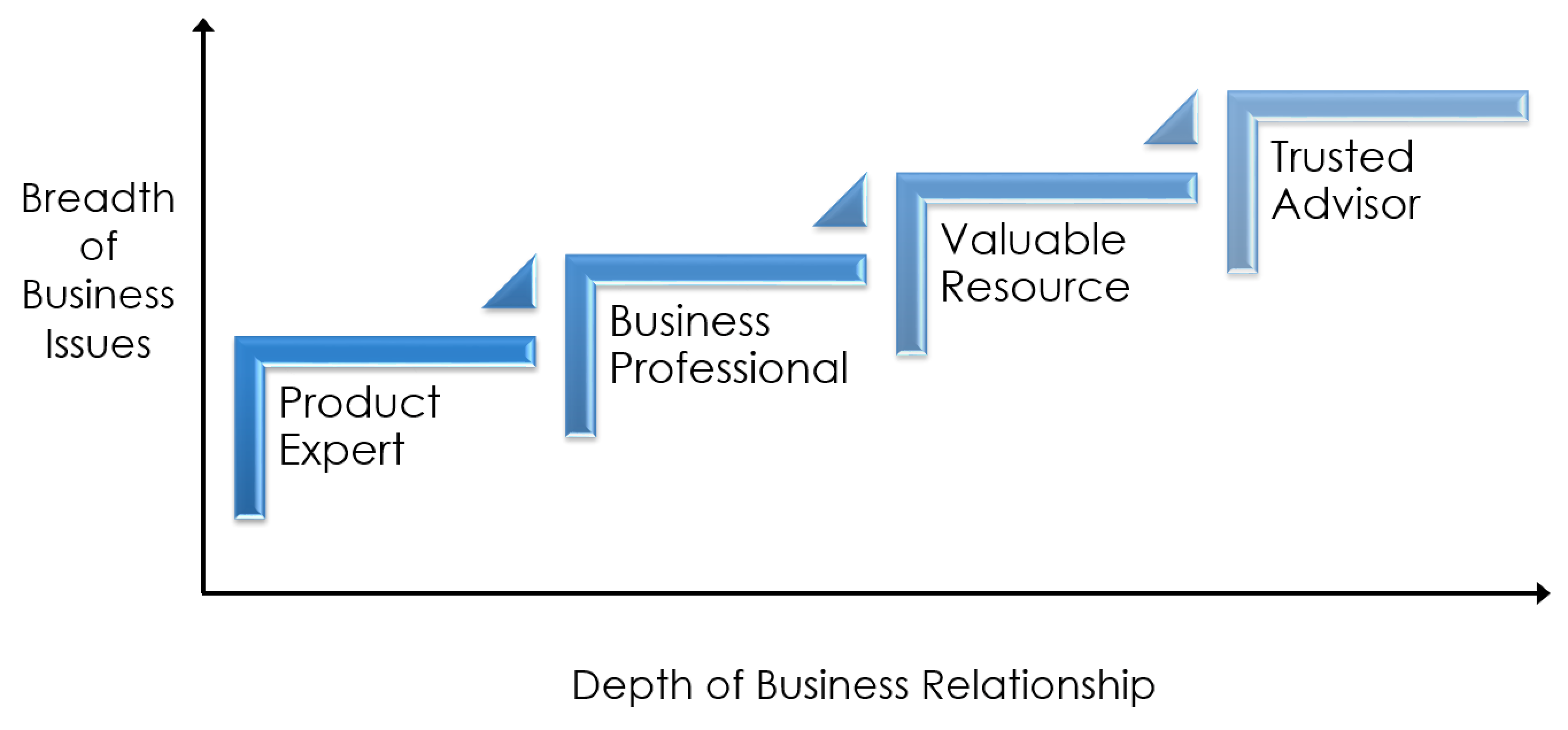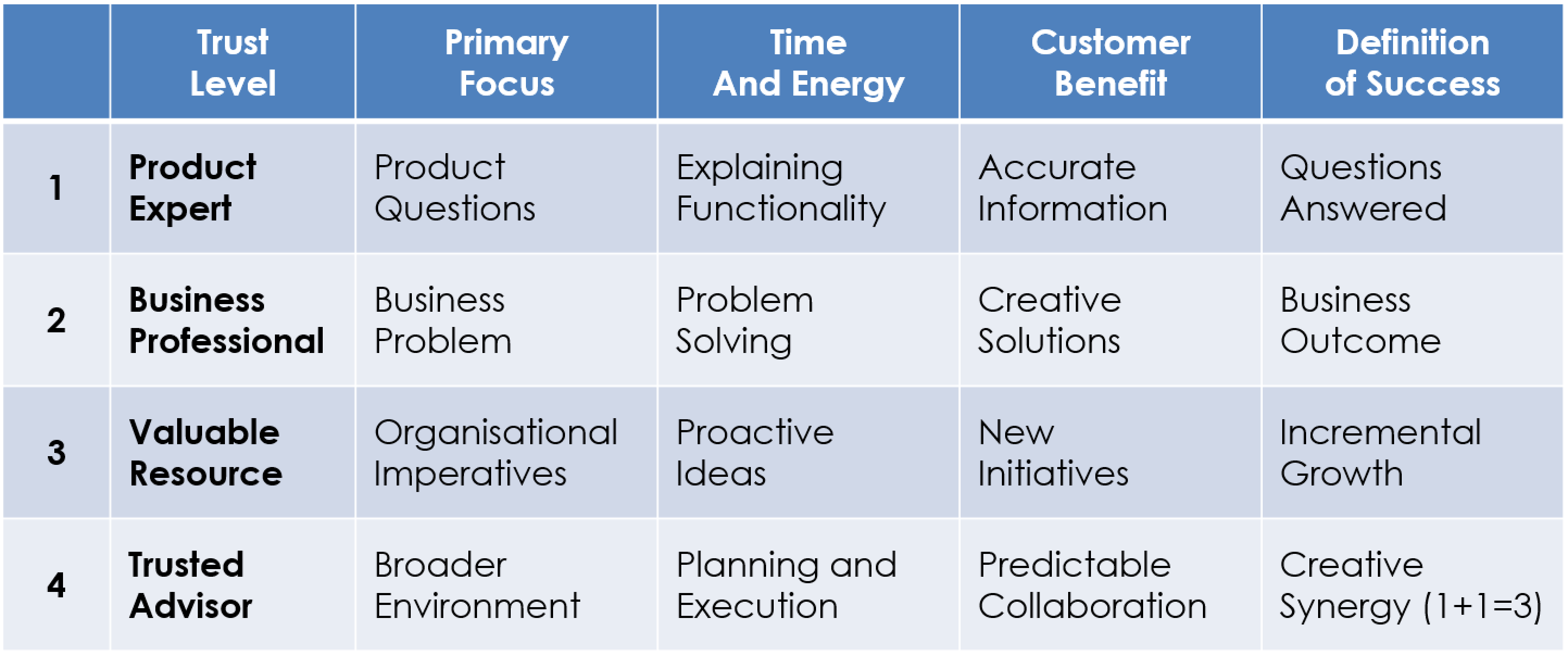If I had to pick my most annoying phrase right now, it would be “Trusted Advisor”. Greatly overused, often misrepresented, and largely misunderstood, those two words are now well and truly entrenched in the “Meeting Bingo” category – they seem to get bandied about without any particular definition or consideration.
But while I may hate the use of the phrase, I absolutely believe in its intent, which is to be an organisation where customers seek your advice, and trust it enough to act on it rather than shop you around. And what’s more, I believe there are four attributes which define what Trusted Advisor status means.
Let’s begin by defining the various levels of trust. We can do this by mapping our understanding across two variables:
1. Breadth of Business Issues – ie. your understanding of their business and the issues that are important to them
2. Depth of Business Relationship – ie. your (personal and/or company) relationship with their business and your access to people of influence
We can then look at how your “position of trust” improves as we increase our knowledge across these two axes, leading to 4 Trust Levels

1. Product Expert
2. Business Insight
3. Valuable Resource
4. Trusted Advisor
In order to better understand these levels, we shall consider 4 attributes – Primary Focus, Time & Energy, Customer Benefit and Definition of Success – to clarify the differences.

Product Expert (Level 1)
The Product Expert’s primary focus is handling product enquiries, and explaining how their product’s functionality addresses the customer’s question. They spend their time and energy providing accurate information, and measure their success by providing the correct answer. They are certainly valuable to an organisation, and meet the first level of trust (Note: there are many who don’t know their product well enough to meet even this level) but they are well below what we would consider qualifies for Trusted Advisor status.
Example: if a customer wanted to know how a particular printer worked, the Product Expert would be able to explain the features and benefits, and compare it to competitive products.
Business Professional (Level 2)
A Business Professional goes beyond the product and focuses on the business problem and how to solve it. They look for creative solutions to address the issue, and measure success by being able to deliver business outcomes. For many companies, this is considered to be a Trusted Advisor, and certainly we would agree that this already indicates a very mature approach to customer engagement, but again, we feel it fall short of the highest level.
Example: A Business Professional may understand that the customer is trying to reduce the unpredictability in printing costs, and may suggest that instead of comparing printers, they consider a Managed Print Service to bring costs under control.
Valuable Resource (Level 3)
A Valuable Resource is someone who focuses on the organisational imperatives, and looks for proactive ideas to drive new initiatives. They measure their success by creating incremental business growth. This is someone who is considered very valuable because they have an intimate understanding of their customer’s business and focused on business outcomes rather than simply addressing a problem.
Example: A Valuable Resource may recognise that printing costs are only a superficial symptom of a much broader organisational imperative to improve efficiency, and may recommend that rather than printing, the customer utilise a combination of tablets for capturing information and a document management system for storage, retrieval and distribution of materials that would normally be printed.
Trusted Advisor (Level 4)
The true Trusted Advisor thinks beyond the organisation and focuses on what’s happening in the broader environment. They spend their energy on planning and execution, and use predictable collaboration to produce creative synergy (ie. where the result of the parties working together is greater than the two companies working independently).
Example: The Trusted Advisor may understand that increased competition has led to customers are becoming less tolerant of delays and cumbersome processes, and may propose a new business process workflow (possibly eliminating printing entirely) around data analytics, AI and personalised user interaction to create a better user experience and increase customer retention.
Summary
As I indicated at the start, I am not opposed to the idea of the Trusted Advisor – I’m just tired of hearing the phrase thrown around as if it has a definite meaning. And while all 4 levels listed above are extremely valuable to customers (remember, some people don’t even meet the minimum requirements of Level 1) we believe the phrase is most fitting for those performing at Level 4.
Feel free to ping me at mmoses@channeldynamics.com.au to let me know what you think, and keep an eye out for next month’s article, where Cam will discuss how to apply this model in territory management, partner engagement and business planning.


